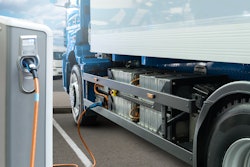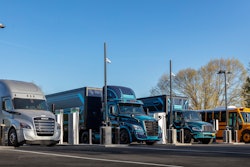
It was a century ago in September that German motorcoach company Benz & Cie test drove the first diesel engine powered truck through the Black Forest.
At the time, the company was attempting to determine if the efficiency improvements displayed in other applications by Rudolf Diesel’s landmark internal combustion engine were achievable within the confines of a motor vehicle application.
The test drive went well, with Benz & Cie’s engineers stating at the time that the new engine required around 25% less fuel than a petrol engine “with the same power.” Rival Daimler-Motoren-Gesellschaft followed that same month with a breakthrough test drive of its air-injection diesel engine prototype on a truck from Berlin to Stuttgart, Germany, and back.
By 1926, the companies would merge to become Daimler Benz, integrating their technology and starting trucking’s first power generation revolution.
Nearly a century later, another revolution is underway.
Electric trucks, which pre-date Benz & Cie’s first test drive but have, for many decades, been absent in commercial trucking, are returning across the globe. Hydrogen fuel cell vehicles also are slowly reaching market readiness. Federal, state and provincial regulators, along with truck makers, shippers and carriers are making public pledges to achieve a zero-emission future for truck transportation. While many of these commitments do not require the sunsetting of diesel engines, they do encourage the adoption of alternative powertrains.
For truck dealers with nearly a century of expertise supporting diesel engines, this uncertain future poses infinite challenges.
In this special report, Trucks, Parts, Service will address why the trucking industry is undergoing this transition, the stakeholders driving the change and the full scope of business investments required by dealers who want to keep up. TPS also will tackle how dealers and service shops can develop timelines and connect with key stakeholders to move their businesses forward, while also identifying major pain points and steps most likely to cause delays.
There is a lot of dirty work required for dealers to support a cleaner trucking future.
Keep up with our special report on trucking's transition to cleaner trucks:
Part II: Why are we doing this?
Part III: What constitutes as ‘alternative power’?
Part IV: What will drive — or inhibit — alternative power adoption?
Part V: Performing an alternative power market analysis
Part VI: What it takes to install charging infrastructure
Part VII: Training on alternative powertrains vital to employee safety, business success
Part VIII: The challenges of building your best EV service bay
Part IX: Making the case: How to effectively sell alternative power
Part X: Safety in the Service Bay
Part XI: How electric trucks may transform dealer revenue streams










